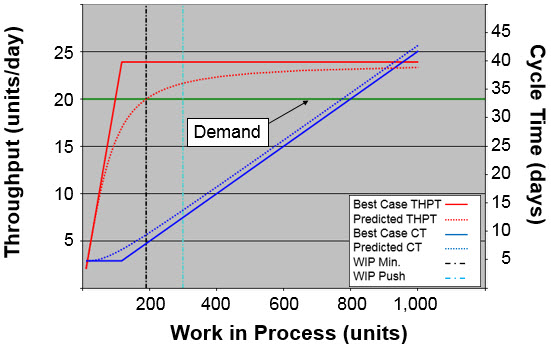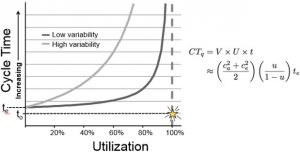We first met Norbert Majerus at one of our Factory Physics seminars in Tampa in 2005. He was just beginning his Lean journey at Goodyear. As Norbert relates it, “When I was asked to take a shot at developing a lean product development process at Goodyear, I started going to conferences, read books, did research on the internet, brought in consultants and tried to find mentors. But the more I educated myself, the more confusing it became—actually a lot of what I had learned contradicted itself. Not until I read Factory Physics did the pieces come together and make sense.1“ Last year after tremendous success in his efforts, his book Lean-Driven Innovation was awarded the prestigious Shingo Prize. Nowadays, we recommend managers start with the less technical Factory Physics for Managers so extra kudos to Norbert for wading through the academic textbook to find his way.
Norbert has provided an excellent description of his efforts in the following blog post. We thank him for his contribution and welcome your comments regarding your own experiences applying Factory Physics concepts in action.
Norbert Majerus, Lean Champion, The Goodyear Tire & Rubber Company
In 2005 I was asked by Jean-Claude Kihn, my CTO at the time, to look into applying lean thinking to the R&D processes of The Goodyear Tire & Rubber Company. I was not happy about the request because of the lack of success of similar initiatives in the industry. But Kihn insisted, and I eventually acquiesced. Goodyear needed to do something: Even though we were launching high-quality products, they were often late to market. We had huge backlogs of projects, some of which would never get to market or do so long after their optimum window for profitability had closed.
We formed a small team, and together my colleagues and I began to expand our understanding of lean in general and, more specifically, how it could be applied to product development. We found empirical wisdom about why lean works and instructions on what to do, but typically from a manufacturing perspective. We also found lots of contradictions and confusion of how and why it works. Of those that addressed product development, some schools were all about knowledge management, others tried to plug in manufacturing tools like 5S, and still others prescribed the safest path (copy Toyota).
Toyota successes were compelling, but we did not make cars and our culture was not facilitating Toyota thinking. Some of the concepts we learned about (e.g., 5S, TPM, quick changeovers) did not seem to make a lot of sense in R&D. Waste elimination seemed to be straightforward, and most of the other examples we read about (e.g., flow, utilization, bottlenecks) kind of made sense, but how would we apply them to our work?
Then one day a colleague handed me a copy of Factory Physics by Wallace J. Hopp and Mark L. Spearman2. She insisted that I actually read all 900 pages (the condensed version for managers had not yet been written3), do some of the exercises in the tome, and attend a workshop by Spearman. For the first time I began to see the science beneath many lean principles and started to understand why some of what I read works, why it works, and where it works. As engineers, my team and I needed this degree of discipline to believe in and try lean. With a foundation in which we had confidence, we had the courage to experiment with lean principles in Goodyear’s Innovation Center in Akron, Ohio. This was a significant barrier to overcome for the Goodyear team, but it wasn’t the only one.
One of the biggest cultural challenges we had at Goodyear was that we thought that everything has a computer solution. All you have to do is buy the right computer tool at the right time (it worked well for our modeling tools). I actually learned from a fellow participant in a Factory Physics workshop that computerizing a bad process creates an expensive bad process.
 Although we started to understand principles like Little’s law, we still had a hard time convincing our leaders that our cycle times were so long because our WIP was too high. Like many lean principles, it was not intuitive. Our leaders repeatedly said, “We don’t believe in Little’s law!” Deciding what to work on is one of the biggest challenges of an R&D organization and typically leads to working on everything possible. Our leaders did not want a formula for less work, they wanted a formula that would secure more resources to do all the work we had accepted. So we turned the law around, and controlled WIP: we only took on as much work as we had the capacity to address, and then we all watched our cycle times drop quickly and our on-time delivery performance improve.
Although we started to understand principles like Little’s law, we still had a hard time convincing our leaders that our cycle times were so long because our WIP was too high. Like many lean principles, it was not intuitive. Our leaders repeatedly said, “We don’t believe in Little’s law!” Deciding what to work on is one of the biggest challenges of an R&D organization and typically leads to working on everything possible. Our leaders did not want a formula for less work, they wanted a formula that would secure more resources to do all the work we had accepted. So we turned the law around, and controlled WIP: we only took on as much work as we had the capacity to address, and then we all watched our cycle times drop quickly and our on-time delivery performance improve.
Our application of Little’s law also had a collateral advantage: projects with a better business case were chosen, and the not-so-good ones waited for capacity to appear. People even understood that if you want to get faster it costs less to control WIP than to add more resources or tools to increase throughput. When the throughput also increased through waste elimination, we used the new capacity for innovation and fundamental work, which we had never able to do before. Eventfully our leadership came up with a “single-piece flow initiative” — who would ever have thought that was possible — and today we schedule one major project per engineer whenever possible, with filler jobs if needed.
 A more difficult sell within Goodyear was the law of utilization or the Kingman equation — cycle time (queue time and work time) increase in a nonlinear fashion (almost exponential) when utilization gets close to 100 percent4. Although engineers and even some managers understood it, they preferred the hydraulic principle (i.e., the more you force into the system, the more comes out completed). In fact, one of our R&D leaders in Europe at the time had hours-long discussions trying to convince colleagues of the efficacy of the utilization formula. He pleaded with his business leaders, “We scheduled 120 project iterations last month, and we delivered 40 on time. Please let me schedule 80 iterations next month, and we will deliver 70 when you need them — a gain of 30 iterations!” Eventually they accepted the science, and he delivered on his promise.
A more difficult sell within Goodyear was the law of utilization or the Kingman equation — cycle time (queue time and work time) increase in a nonlinear fashion (almost exponential) when utilization gets close to 100 percent4. Although engineers and even some managers understood it, they preferred the hydraulic principle (i.e., the more you force into the system, the more comes out completed). In fact, one of our R&D leaders in Europe at the time had hours-long discussions trying to convince colleagues of the efficacy of the utilization formula. He pleaded with his business leaders, “We scheduled 120 project iterations last month, and we delivered 40 on time. Please let me schedule 80 iterations next month, and we will deliver 70 when you need them — a gain of 30 iterations!” Eventually they accepted the science, and he delivered on his promise.
We had made great progress, but our most difficult problem remained: how to understand and better manage variability — and we sure have a lot of that in an R&D process. Factory Physics has an excellent chapter on the subject, but my colleagues did not have the time to read and understand that. I tried to teach formulas and used spreadsheets to illustrate the application of the formulas, but I still had very little success. Then I remembered that we used a simple simulation when we started lean. With the help of a few other books (The Goal5,Velocity6, The Lean Games Book7), I developed simulations that represented our process and the effects of the law of utilization. With the simulations, people understood the principles and consequences, even if they did not understand the formulas that govern variability.
We had come to better understand how to manage time in R&D and the cost of time. Today my challenge is to understand the cost of wasted time: Some experiments create value for the customer, even when they fail. Some experiments create little or no value, and, thus, are mostly waste. Factory Physics does not have a formula for that (yet), and we have yet to figure out how to quantify how much we learn from a failed experiment.
Like most who have pursued lean principles in any industry or function, we realize there is always more improvement possible. Managing experiments is just one more of those opportunities. Nevertheless, we’ve come a long way: Goodyear today gets approximately 1,500 new SKUs to market on time each year, and products introduced within the past three years account for more than 30 percent of the company’s annual revenue. Many science-based principles, such as Little’s law and the law of utilization, are behind the enormous success we’ve had with lean over the past decade, and I documented how we used them in Lean-Driven Product Innovation. When we first came upon Factory Physics, about half of our R&D projects were unprofitable. Today, nearly all projects confirm the positive business case that justified their start in R&D, and in 2015 Goodyear’s operating income exceeded $2 billion.
1 Norbert Majerus, Lean-Driven Innovation: Powering Product Development at The Goodyear tire and rubber Company (Boca Raton, CRC Press, 2016),26.
2 Wallace J. Hopp and Mark L. Spearman, Factory Physics, Waveland Press, Long Grove, IL, 1996.
3 Edward S. Pound, Jeffrey H. Bell, and Mark L. Spearman, Factory Physics for Managers, McGraw-Hill Education, New York, 2014.
4 John Kingman, “The single server queue in heavy traffic,” Mathematical Proceedings of the Cambridge Philosophical Society, October 1961.
5 Eliyahu Goldratt and Jeff Cox, The Goal, North River Press, Great Barrington, MA, 1984.
6 Suzan Bergland, Jeff Cox, and Dee Jacob, Velocity, Free Press, New York, 2009.
7 John Bicheno, The Lean Games Book, Picsie Books, Buckinghamshire, UK, 2009.